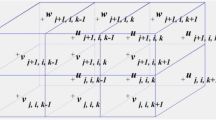Abstract
Tidal current ellipses formed by the Coriolis effect are investigated theoretically, taking account of the effect of horizontal boundaries. This study reveals that even in a narrow bay, the tidal current ellipse appears in the inside of the bottom boundary layer, although the ellipticity cannot be recognized in the outside of the boundary layer. In a wide bay, the ellipticity is observed even in the outside and it is larger in the inside. The rotation direction of these ellipses is counterclockwise in the northern hemisphere. And also, the Coriolis force has an effect to deflect the major axis of the ellipse in the inside of the boundary layer. These nature of the tidal current ellipse is well explained by the consideration of the formation mechanism of the ellipse.
Similar content being viewed by others
References
Lamb, H. (1932): Hydrodynamics. 6th ed. Cambridge Univ. Press, London, 738 pp.
Maas, L.R.M. and J.J.M. van Haren (1987): Observations on the vertical structure of tidal and inertial currents in the central North Sea. J. Mar. Res.,45, 293–318.
May, P.M. (1979): Analysis and interpretation of tidal currents in the coastal boundary layer. Ph. D. Dissertation, MIT, 197 pp.
Prandle, D. (1982): The vertical structure of tidal currents. Geophys. Astrophys. Fluid Dynamics,22, 29–49.
Soulsby, R.L. (1983): The bottom boundary layer of shelf seas.In: Physical Oceanography of Coastal and Shelf Seas, ed. by B. Johns, Elsevier Oceanography Series,35, 189–266.
Sverdrup, H.U. (1927): Dynamics of tides on the north Siberian Shelf. Geophys. Publ.,4, 1–75.
Tsuji, M. (1978): The qualitative property of mean sea condition at the mouth of Tokyo Bay. Bul. Nat. Res. Inst. Pollution and Resources,8, 9–20 (in Japanese).
Yasuda, H. (1980): Generating mechanism of the tidal residual current due to the coastal boundary layer. J. Oceanogr. Soc. Japan,35, 241–252.
Yasuda, H. and M. Yamasaki (1980): Experimental study on the tidal residual current caused by flowseparation. Rep. Govt. Industrial Res. Inst. Chugoku,10, 53–69 (in Japanese).
Yasuda, H. and J.T.F. Zimmerman (1986): Tideinduced residual currents with Stokes and Ekman layers over an undulatory sea floor. J. Oceanogr. Soc. Japan,42, 276–293.
Author information
Authors and Affiliations
Rights and permissions
About this article
Cite this article
Yasuda, H. Vertical structure of the tidal current ellipse in a rotating basin. Journal of the Oceanographical Society of Japan 43, 309–318 (1987). https://doi.org/10.1007/BF02108698
Received:
Revised:
Accepted:
Issue Date:
DOI: https://doi.org/10.1007/BF02108698




